1-2+科技英语的常用句型和翻译技巧s
- 格式:doc
- 大小:139.00 KB
- 文档页数:9
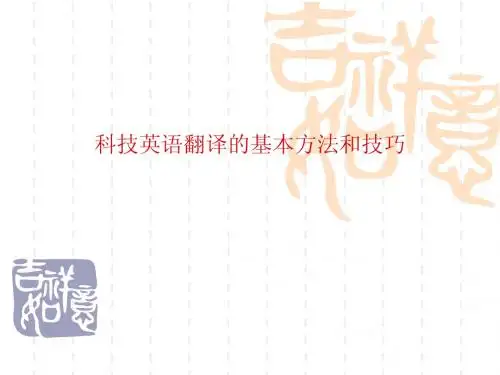
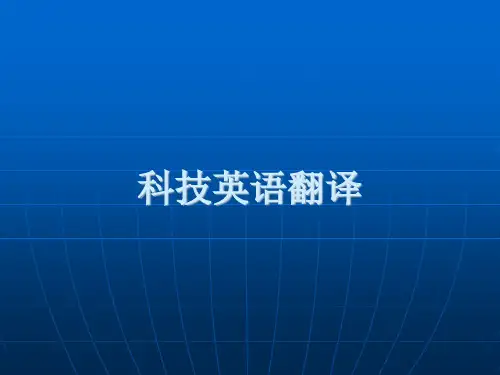
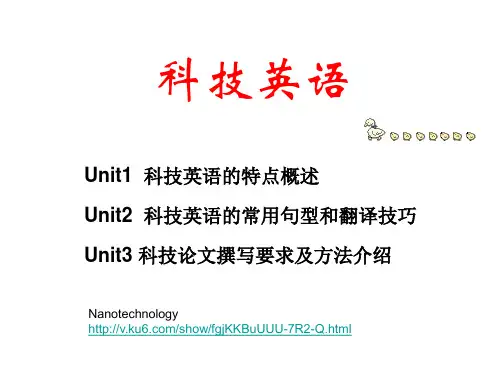
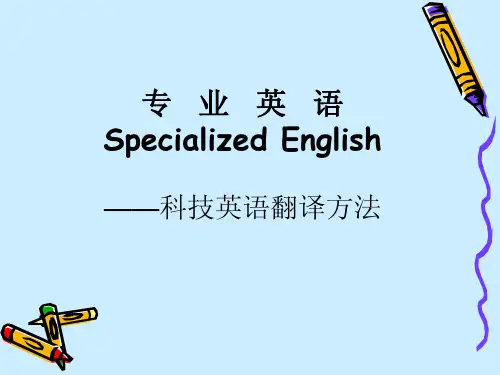
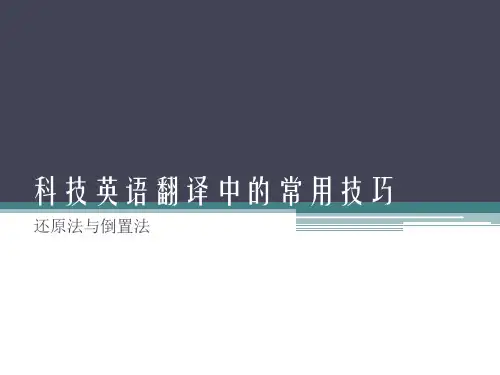
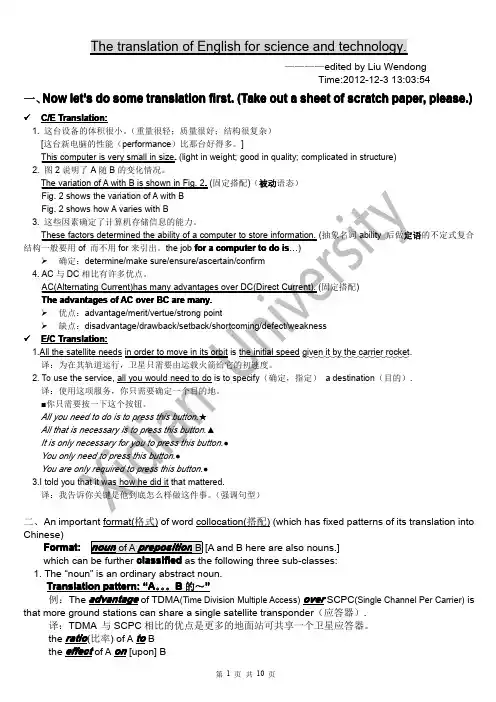
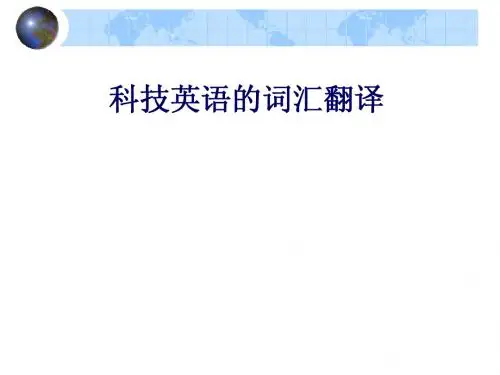
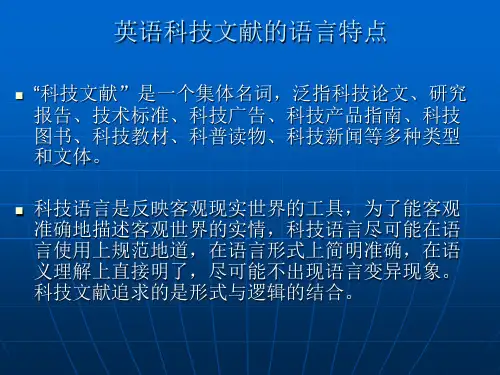
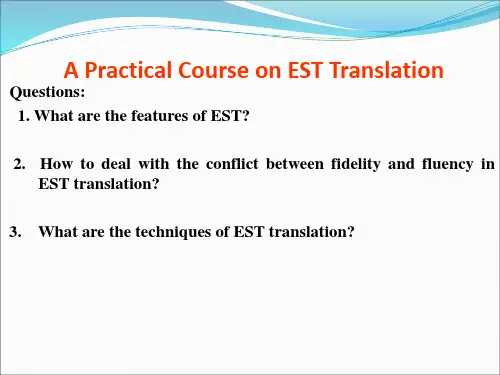
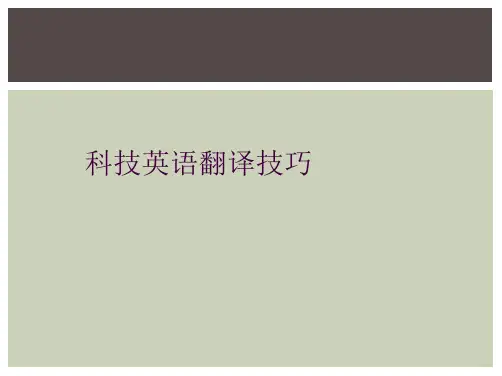
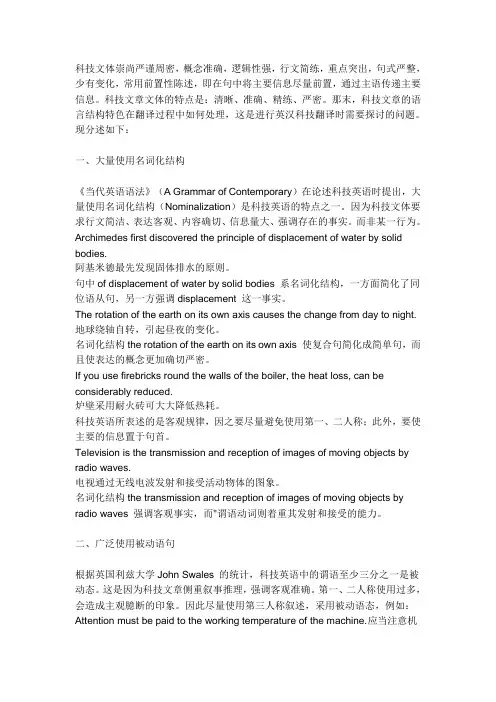
科技文体崇尚严谨周密,概念准确,逻辑性强,行文简练,重点突出,句式严整,少有变化,常用前置性陈述,即在句中将主要信息尽量前置,通过主语传递主要信息。
科技文章文体的特点是:清晰、准确、精练、严密。
那末,科技文章的语言结构特色在翻译过程中如何处理,这是进行英汉科技翻译时需要探讨的问题。
现分述如下:一、大量使用名词化结构《当代英语语法》(A Grammar of Contemporary)在论述科技英语时提出,大量使用名词化结构(Nominalization)是科技英语的特点之一。
因为科技文体要求行文简洁、表达客观、内容确切、信息量大、强调存在的事实。
而非某一行为。
Archimedes first discovered the principle of displacement of water by solid bodies.阿基米德最先发现固体排水的原则。
句中of displacement of water by solid bodies 系名词化结构,一方面简化了同位语从句,另一方强调displacement 这一事实。
The rotation of the earth on its own axis causes the change from day to night. 地球绕轴自转,引起昼夜的变化。
名词化结构the rotation of the earth on its own axis 使复合句简化成简单句,而且使表达的概念更加确切严密。
If you use firebricks round the walls of the boiler, the heat loss, can be considerably reduced.炉壁采用耐火砖可大大降低热耗。
科技英语所表述的是客观规律,因之要尽量避免使用第一、二人称;此外,要使主要的信息置于句首。
Television is the transmission and reception of images of moving objects by radio waves.电视通过无线电波发射和接受活动物体的图象。
【关键字】英语翻译是把一种语言里已经表达出来的事物用另一种语言准确流畅地进行重新表达的过程。
与其他题材的文章相比,科技专业文章在内容、表达形式和风格上有很大的差别,具有科技性强、专业性强、逻辑严密、表达要求简练的特点,在翻译上力求准确全面、严谨明确和通顺简练。
1科技英语翻译遵循的基本原则从科技文章的特点来看,大多具有以下几个特征:述说事理、逻辑性强、结构严密、术语繁多,语言严谨、数据精确。
这就要求译文必须概念清楚、条理分明、逻辑正确、数据无误,尤其对定义、定律、公式、图表、结论等更应特别注意。
科技英语作为特殊英语的一个分支,在词汇构成、遣词造句等方面都有其自身的特点,其语法结构不十分严密、语言习惯和汉语也有不少差别、词汇量大、词语繁多,因此科技英语翻译起来比较困难。
另外,科技文章比较重视叙事逻辑上的连贯及表达上的明晰与畅达;躲免行文晦涩,躲免表露个人感情,躲免论证上的主观随意性。
因此,科技英语翻译力求少用或不用描述性形容词以及具有抒情作用的副词、感叹词及疑问词,而是大量使用科技词汇、专业技术用语,译者应尊重客观事实,不能随意改动数据、回躲不易翻译的文字,更不能加进自己的主观想象,进行自由翻译。
我国著名翻译家严复提出的“信、达、雅”三准则一直为不少翻译工作者所接受。
“信”指的是译文要忠实于原文,“达”是指译文的通顺达意,“雅”指的是译文的用词修辞。
三准则体现了译文和原文信息等值这一基本要领。
“信、达、雅”的翻译准则对各种英语文体的翻译实践都具有指导意义,是衡量一篇译文好坏的标准,也同样适用于科技文献的翻译。
由于科技文章特有的文体特征,与其他类文章相比,其“达”和“雅”的内涵不同,它要求在准确传达信息的基础上,使译文更加简洁明快,流畅通顺。
2科技英语翻译的基本方法英语翻译的过程是一个信息传达的过程,首先由译者理解原文,然后把他所理解的东西用另一种语言表达出来。
翻译过程包含理解和表达两个阶段,理解阶段的关键是透彻理解和把握住原文的内容和实质,要从整体出发,结合专业内容,通过对词汇和语法的分析,彻底弄清原作的内容和逻辑关系。
两分钟做个小测试,看看你的英语程度美联英语提供:科技英语翻译技巧科技英语翻译的5种常用翻译技巧1 顺译法:(Synchronizing)有些英语长句所表达的事物根本上是按照时间或逻辑的顺序安排的。
这与汉语表达的方法根本一致,因此翻译一般可以按照原文顺序译出。
例如:1(1) For these forms of pollution as for all the others, (2) the destructive chain of cause and effect goes back to a prime cause: (3) too many cars, too many factories, more and more trials left by supersonic jutes, inadequate methods for disinfecting sewers, too little water, too much carbon monoxide.这个句子是由一个主句、一个状语和一个同位语组成的。
主句是(2) 破坏的因果关系链可归根于一个主要原因,也是全句的中心内容。
主句前的(1)是方式状语,(3)是主句的同位语。
原文各句的逻辑关系、表达顺序与汉语完全一致,因此可以按照原文的顺序翻译。
译文:这些形式的污染象所有其他形式的污染一样,起破坏性的因果关系链可可归根于一个主要的原因:太多的汽车、工厂、洗涤剂、杀虫剂,越来越多的喷气式飞机留下的尾气,缺乏的污水消毒处理方法,太少的水源,太多的一氧化碳。
2 (1)Fossil fuel emit another 5.2 billion metric tons of CO2 into the air each year, (2) while the burning of tropical forests emits roughly 1.8 billion metric tons of CO2-(3) both contributing to a build up of carbon dioxide (4) that willsoon trigger the greenhouse effect. 在这个句子中,主句是(1),(2)是主句的并列句,(3)是同位语,(4)是定语从句。
《专业英语(制药工程)》【科技英语的常用句型和翻译技巧】一、概述1. 翻译的要求The Criteria of Translation:信、雅、达2. 科技英语词汇(上节课已经介绍)3. 科技英语句子的特点二、科技英语常用句型及翻译1. 被动语态1)被动语态的常用原因常用被动语态主要见于以下几个方面:①不必或无法说出主动者For a long time aluminum has been thought as an effective material for preventing metal corrosion.长期以来,铝被当作一种有效的防止金属腐蚀的材料。
►The book has already been translated into many languages.②强调行为对象,而非行为者,将行为对象作为句子的主语Three machines can be controlled by a single operation.三台机器能由一个操作者操纵。
►The work must be finished at once.③为了更好的联系上下文►They are going to build a library here next year. It is going to be build beside the classroom building.2)被动语句的翻译方法(1)仍译为被动句最常见的是在谓语前加上助词“被”,也可使用“受到,遭到,得到,叫,称,让,给,加以,为……所”等句式。
偶尔也可不加任何词直接译出。
We remember how air can be made into a liquid. If the liquid is warmed again, it “boiled”and turns back into a gas.我们记得是如何把空气制成液体的。
如果给这种液体重新加热,它“沸腾汽化”,就又还原成气体。
科技英语翻译技巧主要介绍三个方面的内容:科技英语特点、科技英语翻译的一般知识以及科技英语翻译的一般技巧。
一、科技英语特点1、以客观陈述为主,较多使用被动句科技人员在研究和解决科技问题时重视事物本身的客观规律、主观事实和方法、性能和特征,在讨论科技问题是力求客观而准确的陈述。
因此,在科技文献中通常以非人称的语气作客观的叙述,较多使用被动句。
例:The lengthof the polymer chainis specifiedby the number of repeatunitsin the chain. This is called the degree of polymerization. Unlike many products whose structure and reactions were well known before their industrial application, some polymers were produced onanindustrial scale longbefore their chemistryor physics was studied.2、大量使用科技词语科技文献中除了使用各学科专用的科技词语外,还广泛使用各学科通用的半科技词语和书面的非科技词语。
专用的科技词语仅用于某个学科或专业的词汇或术语。
半科技词语指那些日常用于英语,但又是科技英语中常用的那些词汇。
例:reaction。
书面非科技词语指主要用于科技英语但却严格地属于非科技性质的词语。
例:apply, to yield, generation, available,at the rate of 按~~的比率,以~~ 速度; in terms of 用、借助于3、表达方式程式化文章结构程式化:标题、摘要,正文(引言、论述、结论)。
(1 )介绍某个过程或功能及达到某种目标时,一般用动词不定式短语构成目的状语,放在句子的开头。
《专业英语(制药工程)》【科技英语的常用句型和翻译技巧】一、概述1. 翻译的要求The Criteria of Translation:信、雅、达2. 科技英语词汇(上节课已经介绍)3. 科技英语句子的特点二、科技英语常用句型及翻译1. 被动语态1)被动语态的常用原因常用被动语态主要见于以下几个方面:①不必或无法说出主动者For a long time aluminum has been thought as an effective material for preventing metal corrosion.长期以来,铝被当作一种有效的防止金属腐蚀的材料。
►The book has already been translated into many languages.②强调行为对象,而非行为者,将行为对象作为句子的主语Three machines can be controlled by a single operation.三台机器能由一个操作者操纵。
►The work must be finished at once.③为了更好的联系上下文►They are going to build a library here next year. It is going to be build beside the classroom building.2)被动语句的翻译方法(1)仍译为被动句最常见的是在谓语前加上助词“被”,也可使用“受到,遭到,得到,叫,称,让,给,加以,为……所”等句式。
偶尔也可不加任何词直接译出。
We remember how air can be made into a liquid. If the liquid is warmed again, it “boiled”and turns back into a gas.我们记得是如何把空气制成液体的。
如果给这种液体重新加热,它“沸腾汽化”,就又还原成气体。
►Every thing is built up of atoms.►The process by which energy is changed from one form into another is called the transformation of energy.Water is usually considered as being a compound of two elements.(2)译为主动句,中国汉语的习惯①译成无主语的主动句Measures have been taken to diminish air pollution.已经采取了一些措施来减少空气污染。
►If the product is a new compound,the structure must be proved independently.►Quality must be guaranteed first.②加上不确定主语的主动句Salt is known to have a very strong corroding effect on metals.大家知道,盐对金属有很强的腐蚀作用。
►All bodies are known to possess weight.►If one or more electrons are removed, the atom is said to be positively charged.③由by短语中的动作发出者作为主语Heat and light are given off by the chemical reaction.这种化学反应能发出热和光。
►The planets are held together by attractive forces.►Every day, new compounds are produced in the laboratory by the synthetic organic chemist. (3)译成判断句Currently most solar cells are made from crystals of high-purity silicon.目前,绝大多数太阳能电池是用高纯度的硅晶体制成的。
►Large quantities of oil are refined locally at Abadan, Iran, in Bahrain and elsewhere.Produced by electrons are the x-ray, which allow the doctor to took aside a patient’s body. (4)译成因果句The crops were badly damaged by a flood. 农作物因水灾而毁坏。
The multiplicity of carbon compounds is explained in the exceptional ability of carbon atoms to combine with one another.碳化合物之所以为数众多,是因为碳原子相互结合的能力特别强。
►The existence of organic chemistry is further justified by the importance of carbon compounds or mixtures in our lives.2. 从句科技英语大量使用复合句是其重要的特征之一,一个复合句可能由主句和多个主句组成。
理解和掌握各种从句的译法对理解和翻译科技英语是非常重要的。
1)主语从句①基本句型:连词(连接代词、连接副词)+主语+谓语+谓语Why dinaucers became extinct remained a mystery for a long time.恐龙为什么绝迹长期以来是个谜。
►Whether there is life on the Mars is a disputable topic.②用what引起的主语从句What we call weight is really the gravitational pull on an object.我们所称之重量实际上是对某一物体的地心引力。
►What cannot be seen with the eye can be easily found with a radar instrument.③用it做主语的复合句►It is important that the metal for making aeroplanes should resist corrosion.☺It is said that all matters is made up of atoms.2)宾语从句①带有宾语从句的复合句:一般按原句顺序翻译A product must be carefully tested to determine if it will perform its job properly and reliably.产品必须自己检查,以确定是否合格可靠。
►Newton believed that gravitation is everywhere——that is, it is universal.②用what引起的宾语从句常有“the thing which”的含义,译为“所……的东西(或事物)”:The computer can only do what they are told to do.计算机只能做人们所要它做的事情。
►When the atoms of different elements combine or react chemically, they form what are called “molecules”.③介词所带的宾语从句除动词外,介词也可带有宾语从句,这时从句不能用that引导,而是连接代词或连接副词引导,翻译时要把宾语从句处理成一个短语。
Energy is rather difficult to define, but most of us have a concept of what it is.给能量下定义是相当不容易的,但我们大多数人对这一概念都有所了解。
►The value of a machine depends on how much work it can do per hour, or per second.④符合宾语中的宾语从句►Time and again Newton made it clear that motion is relative.☺Ancient people believed it to be true that the sun turned around the earth.3)表语从句①表语从句一般译法►One of the most important facts about light is that it travels in straight line.☺Why don’t we fall off the earth? The answer is that gravity keeps us from falling off.②由what引起的表语从句Oil coming from the ground is what we call crude oil.从地下喷出的石油就是我们所说的原油。
►Carbon is what makes up a major ingredient in coal, wood, gasoline, oil, or any other fuel. 4)同位语从句①把同位语从句译在其先行词之前,二者之间用“这一”或“的”连接。
The question whether there is life on Mars is still disputable.火星是否有生命这一问题仍在争论之中。
►The distilling unit separates oil into different products by taking advantage of the fact that the hydrocarbons boils at different temperatures.②按照原文顺序翻译,在先行词前加“这一”等次,其后加冒号或破折号,然后译出同位语从句,这种方法只能用在同位语从句及其先行词不在句首的复合句中。